
This gun was used as a Dual-Purpose (DP) secondary on the King George V and Vanguard battleship classes and as the main guns on the Dido and Spartan cruiser classes. This was a somewhat large caliber for a DP gun, but chosen because it was considered that this size would provide the maximum weight of shell that could still be manually handled by the average gun crew. Unfortunately, the original design of the gunhouse was cramped and the heavy projectile and cartridge cases resulted in a lower rate of fire than expected. In addition, the slow elevating and training speeds of the mounts were found to be inadequate for engaging modern high-speed aircraft.
The later mountings designed for HMS Vanguard enjoyed a much improved RPC system and were coupled with the USN's outstanding Mark 37 fire control system which eliminated the manually-operated fuze-setters used in the previous mountings, giving the gun crews a roomier working space. However, Vanguard did not see service until long after World War II had ended and she was destined never to fire her guns in anger.
'A' turret in the early Dido class cruisers was prone to jamming with some thirteen separate incidents being reported during 1940-41, including that of HMS Bonaventure while engaging the German heavy cruiser Admiral Hipper in December 1940. These problems were mainly the result of the light construction methods used on most Treaty-limited ships, which in this case allowed the bow to flex in heavy weather or during high-speed turns. This was rectified in the early ships by stiffening the bow section and by more careful attention to the detail fitting work required for installation of the mountings. Later ships had these modifications incorporated during their construction and no problems of this nature were encountered for these cruisers. It is also recorded that after the winter of 1941 the captains of the early ships "handled them appropriately" during heavy weather which also alleviated the problem. However, in 1950 HMS Euryalus had 'A' turret permanently out of action due to problems with the roller path. D.K. Brown, RCNC, noted that his experience in HMS Euryalus was that these mountings were "generally unreliable."
These mountings proved difficult to manufacture and the King George V battleships were given the highest priority of what guns and mountings were produced. As a result, the Dido class cruisers HMS Charybdis and HMS Scylla were completed with eight 4.5" (11.4 cm) guns and three other cruisers, including HMS Dido herself, were completed with only eight 5.25" (13.3 cm) guns. HMS Dido had her fifth turret installed during a refit late in 1941 at the Brooklyn Navy Yard, while HMS Bonaventure was sunk in March 1941 and HMS Phoebe remained an eight-gun cruiser. The later Spartan class were designed from the start with eight guns.
Constructed of autofretted loose barrel (no liner), jacket to 99 inches (2.5 m) from the muzzle, removable breech ring and sealing collar. Used a hand-operated horizontal sliding breech block with semi-automatic opening. It was necessary to dismount the gun in order to change barrels. A total of 267 guns were manufactured of which six were loaned to the Army.
A further naval development, the Mark IV gun in the Mark III twin mounting, was to have vertical-sliding breech blocks, fire fixed ammunition and have a higher rate of fire. Two experimental guns were ordered in 1944, but the mounting never progressed beyond the sketch stage. A postwar project for a twin Mark III mounting capable of 70 RPM using fixed ammunition did not make it off the drawing board.
Nomenclature note: The 5.25" (13.3 cm) Mark II, Mark III and Mark V were Army AA guns with a higher muzzle velocity. Only a few of these guns were manufactured. They differed from the Navy guns by having a stronger breech ring and breech block.
| Designation | 5.25"/50 (13.3 cm) Mark I |
|---|---|
| Ship Class Used On | King George V, Dido, Spartan, Lion and Vanguard Classes
The prototype was installed on Iron Duke in 1939 |
| Date Of Design | 1935 |
| Date In Service | 1940 |
| Gun Weight | 9,616 lbs. (4,362 kg) 1 |
| Gun Length oa | 275.5 in (6.998 m) |
| Bore Length | 262.5 in (6.668 m) |
| Rifling Length | 228.5 in (5.803 m) |
| Grooves | (36) 0.0465 in deep x 0.3053 (1.18 x 7.755 mm) |
| Lands | 0.1528 in (3.881 mm) |
| Twist | Uniform RH 1 in 30 |
| Chamber Volume | 894 in3 (14.65 dm3) |
| Rate Of Fire | All except Vanguard: 7 - 8 rounds per minute 2 Vanguard: 9 rounds per minute 3 |
- ^Loose barrel weighed 1.654 tons (1.681 mt) and the SA breech mechanism weighed 473 lbs. (214.5 kg).
- ^As designed, the expected rate of fire for these guns was 10 - 12 rpm. However, the heavy weight of the projectile and cartridge case plus the semi-automated fuze setting mechanism meant that this round required much crew handling before it could be rammed into the breach. The tight design of the gunhouse also interfered with the smooth crew operation necessary to achieve high rates of fire. In the chapter regarding the design of the King George V class, "British Battleships of World War Two" states that: "The mounting was designed for a rate of fire of ten to twelve rounds per minute, but, in fact, the crews could not transfer shell and cordite from the hoists to the loading-trays at this speed, and the more usual rate of fire was seven to eight rounds per minute." This would imply that cruisers would have a similar rate of fire, as the layout of their gunhouse and movement of ammunition was essentially the same as for the battleship mounting.
- ^"Battleships: Allied Battleships in World War II" states that for HMS Vanguard: "The guns were fully automatic (sic) and remotely controlled, with a rate of fire of eighteen rounds per minute." This ROF figure is sometimes taken to be a per gun value, but no other source supports this claim. Contrary to this source, these guns were not "fully automatic" and much of the handling and loading of ammunition continued to be manually worked, just as in the previous 5.25" (13.3 cm) mountings. I believe that the "automatic" comment of the authors in this work may have been referring to the Metadyne automatic fuze setting equipment at the top of the hoists, which was controlled by the Mark 37 GFCS supplied by the USN and similar in concept to that used for the USN 5"/38 (12.7 cm) mountings. The mountings for Vanguard also had a powered loading tray with an automatic ramming link, unlike the manually operated trays used in earlier mountings. As a result of these improvements, the manual handling by the gun crew would have been significantly reduced plus the roomier gunhouse should have allowed freer crew movements. However, this ROF figure still seems high to me, especially when compared to the post-war 4.5"/45 (11.4 cm) guns on HMS Ark Royal - 15 rpgpm - and to that for the contemporary USN 5"/54 (12.7 cm) Mark 16 - 15 to 18 rpgpm - both of which fired separate ammunition with lighter projectiles and the latter having a superior ammunition feed system and better gun loading arrangements. For these reasons, I believe that the figure given for Vanguard is probably the combined rate of fire for both guns together and thus the actual ROF per gun would be closer to the figure given in the table above. This figure still represents a significant 13 to 29% improvement in ROF over the earlier mountings.
- A proposed light cruiser design in 1944 was to have a modified twin mounting which was to be capable of 12 rounds per minute per gun. Five of these ships were included in the 1944 program but Adm. Cunningham, the new First Sea Lord, wanted 6 inch (15.2 cm) cruisers, so the five cruisers and their new mountings were cancelled.
| Type | Separate |
|---|---|
| Projectile Types and Weights | SAP Mark IC - 80 lbs. (36.3 kg)
SAP Mark II - 80 lbs. (36.3 kg) HE - 80 lbs. (36.3 kg) Anti-radar - N/A (probably 80 lbs. (36.3 kg) as other shells) |
| Bursting Charge | SAP - 3.25 lbs. (1.47 kg) TNT
HE - about 6.5 lbs. (2.95 kg) TNT Anti-radar 1a - None (aluminum foil) |
| Projectile Length | SAP - about 24 in (61 cm)
HE - N/A |
| Propellant Charge | 18.05 lbs. (8.19 kg) SC or 21.0 lbs. (9.53 kg) NF/S | Cartridge Case Type, Size and Empty Weight | Brass, 133 x 782 R mm, about 23.0 lbs. (10.4 kg) |
| Muzzle Velocity | 2,672 fps (814 mps) 2a |
| Working Pressure | 20.5 tons/in2 (3,230 kg/cm2) |
| Approximate Barrel Life | 750 rounds |
| Ammunition stowage per gun | King George V and Lion: 400 rounds
Vanguard: 391 (111 SAP + 280 HE) rounds Dido and Spartan: 340 rounds 3a |
- ^Anti-radar projectiles were a late war addition, issued to ships operating in the Indian and Pacific Oceans. About 200 rounds per ship were carried.
- ^The muzzle velocity for the Mark II Army gun was 2,850 fps (869 mps) with a working pressure of 22.0 tons/in2 (3,460 kg/cm2). Propellant charge not available.
- ^The Dido class had up to 360 rounds for 'A', 'B' and 'Q' turrets, 320 rounds for 'X' turret and 300 rounds for 'Y' turret. "British Cruisers of World War Two" states that the Mark II mounting design used on these ships maximized the available ammunition space and allowed 200 more rounds in a 5-turret ship then would have been possible if the Mark I mounting had been used.
- Outfit included SAP, HE and illumination rounds. After about 1942, SAP "K" shells were introduced which contained dyes for coloring the shell splashes. Unlike larger caliber "K" shells, these did not contain a separate fuze and burster for dispersing the dye.
- Star shell allowance was 400 for battleships and 250 for light cruisers. Vanguard also had 25 low-angle and 50 high-angle practice rounds per gun.
- VT fuzed HE was introduced in 1944, equipping between 25 to 50% of the HE rounds by 1945 depending upon availability.
| Elevation | Range |
|---|---|
| 45 degrees | 23,400 yards (21,397 m) |
| AA Ceiling @ 70 degrees | 46,500 feet (14,170 m) |
There are disagreements in the sources below as to the maximum range and AA ceiling of these guns. I have chosen to use those figures given in "Naval Weapons of World War Two."
| Range | Side Armor | Deck Armor |
|---|---|---|
| 9,500 yards (8,690 m) | 3.0" (76 mm) | see Note |
Data from "Nelson to Vanguard: Warship Design and Development 1923-1945" page 85. Assumes a perpendicular impact. Armor type not specified. This same reference states that this projectile was incapable of penetrating 2.0" (51 mm) of deck armor at any range.
| Range | NC Side Armor | Deck Armor |
|---|---|---|
| 13,000 yards (11,900 m) | 2.5" (64 mm) | --- |
Data from "British Battleships of World War Two." Assumes a perpendicular impact.
| Designation 1b | Twin Mounts 2b King George V (8) and Lion (8): Mark I Vanguard (8): RP10 Mark I* Dido (5): Mark II Spartan (4): RP10 Mark II |
|---|---|
| Weight | Mark I: 77.5 tons (78.7 mt)
Mark II: 84-96 tons (85.3-97.5 mt) RP10 Mark I*: 95 tons (96.5 mt) RP10 Mark II: N/A |
| Elevation | -5 / +70 degrees |
| Elevation Rate | Mark I and Mark II: 10 degrees per second
RP10 Mark I* and RP10 Mark II: 20 degrees per second |
| Train | Mark I Mount: about +80 / -80 degrees
Mark II Mount: about +150 / -150 degrees Vanguard: about +80 / -80 degrees |
| Train Rate | Mark I and Mark II: 10 degrees per second
RP10 Mark I* and RP10 Mark II: 20 degrees per second |
| Gun recoil | 24 in (61 cm) |
- ^As noted above, wartime shortages meant that three of the Dido class cruisers were completed with only four instead of five turrets and two others were completed with eight 4.5"(11.4 cm) guns. For obscure reasons, the third turret on the bow of the Dido class ships was designated as 'Q' turret, not 'C' turret. The full set of designations, starting from the bow, went A, B, Q, X and Y. Most eight-gun cruisers, including the follow-on Spartan class, had turrets in A, B, X and Y positions. Somewhat unusually, HMS Bonaventure was completed with turrets in A, B, Q and Y positions, X not being installed. She was lost in March 1941 before her fifth turret could be added. In the opinion of Captain Jack Egerton of HMS Bonaventure in his report of her action with the German cruiser Admiral Hipper: "I have always held that it is better for the four turret ships of the Dido class to have three turrets forward and one aft, as in Bonaventure, than two and two in Dido and Phoebe." Captain Egerton held his ship bow-on to Admiral Hipper as much as possible during the engagement as this allowed him to bring three-quarters of his armament to bear while maintaining a small target to the enemy cruiser. During this battle, Bonaventure fired 438 rounds during 24 minutes of firing, mainly from the forward armament. No hits were obtained on Admiral Hipper, which during the beginning of this time was firing at merchant vessels and later mainly at HMS Berwick which she struck with a few 20.3 cm (8") shells, one of which knocked out her 'X' turret.
- ^Other than the bow flexing problem and some early problems with the "Weak design of turret pumps and overheating of oil" (as per "Mediterranean Fleet Gunnery Experience 1940-1941" report by Adm. A B Cunningham to the Admiralty 1240/366/60 – dated 7 August 1941) these weapons were considered to be reliable in service. Alan Raven in "British Cruiser Warfare" states that his review of official reports from the actions of 1941 did not find "any critical comments on the 5.25in mounting or guns" other than the bow flexing issues.
- The mountings used on the King George V and Dido classes were very cramped and difficult to maintain. They were also difficult to train in the unpowered mode using the hand mechanisms. Their rather slow training speeds meant that they could not track fast-moving aircraft. These last two problems were highlighted during the Japanese attacks on HMS Prince of Wales. When she took up a 10-11 degree list as a result of damage received, it was found that some of the mounts could not be trained to engage the succeeding attacks.
- The Mark I mounting used on battleships was a "short trunk" design where the shells and cartridges were sent to a handling room just below the mounting.
- The following description is adapted from "Naval Weapons of World War Two" by John Campbell: The ammunition supply for the King George V class was different for end and middle mountings. In P1, P4, S1 and S4, there were three fixed electric-powered, endless-chain hoists for LA shell, HA shell and cartridges. These hoists ran from the shell room and magazines to a handling room below each mounting. Here, shells and cartridges were fed into chutes leading to circular rings around the mounting at working chamber level. Cartridges were passed to hand-ups to the gunhouse while HA and LA shells were raised by hydraulic pusher hoists for each gun. The HA hoists raised the shell horizontally to a hand-controlled extension hoist near the inner trunnions. The shell then rolled into the fuze setting tray and afterwards was then moved by hand to the loading tray. The LA hoists came up in rear of the HA hoists with the shell raised vertically and was moved by hand to the loading tray. The loading tray was manually operated but ramming was hydraulically operated. In P2, P3, S2 and S3, there were two sets of fixed lower hoists with a break and transfer via chutes on the lower deck. The shell hoists of the lower set were dredger type, with the shells horizontal and not vertical as in the endless-chain hoists. Otherwise, the supply was the same as for the end mountings.
- The Mark II mounting used on cruisers was a "long trunk" design with a combined magazine and shell room on one deck. The trunk contained two HA shell hoists, two LA shell hoists and two cartridge hoists. All hoists were hydraulic pusher types which delivered shells to the gunhouse as in the Mark I mountings. Movement of shells and cartridges inside the gunhouse was the same as for the Mark I mounting. These changes reduced manning by about 12 crewmen compared to the Mark I mounting.
- Mounting weights given above include crew and ammunition on the revolving structure.
- Mark I and Mark II mountings were driven by a 80 bhp (peak 160 bhp) electric motor and oil hydraulic pump mounted on the revolving structure. Training was by a hydraulic motor with two worm and pinion drives. Elevation was by a hydraulic motor for each gun which drove a worm gear. Hand gears were provided for both elevation and training. Compressed air was used for runout. Guns were individually sleeved. Guns needed to be dismounted in order to change barrels. A total of twelve crewmen were in the gunhouse plus additional crew in the handling and magazine spaces.
- Following the Bismarck battles, King George V and Prince of Wales had their 5.25" (13.3 cm) mountings modified to improve the watertightness of their mantlet plates. These changes were incorporated into the rest of the class as they were being built. Following the loss of Prince of Wales, mountings on the surviving class members had duplicated power leads installed and additional protection worked in to protect the cable entries into the mountings.
- RP10 mountings were equipped with RPC. These mountings had vertical rollers added to steady the turret, the drives in the training and elevating gear were altered to smooth the motions and the loading tray was converted to power operation with an automatic ramming link.
- Late in World War II, the two after mountings on the cruiser Argonaut and all eight mountings on the battleship Anson were converted to the RP10 standard.
- During the war, two of the surviving five-turret ships, HMS Euryalus and HMS Argonaut, had 'Q' turret removed and replaced with a quadruple 2-pdr. mounting. HMS Phoebe completed with four turrets and a 4"/45 (10.2 cm) Mark V gun in place of 'Q' turret. This was replaced in 1942 with a quad 2-pdr. which was in turn replaced by a quad Bofors mount in 1943. HMS Cleopatra had her 'Q' turret replaced by a quad Bofors in 1944. The remaining two ships, HMS Dido and HMS Sirius, retained their 'Q' turret and were not upgraded with newer electronics as were the other ships.
- The Vanguard's RP10 Mark I* mountings were similar to earlier battleships but were roomier inside as the fuze setting equipment was removed and instead she had automatic fuze setters installed. The relative positions of the HA and LA hoists were transposed compared to the earlier mountings so as to allow the use of Mark VII Metadyne fuze setters, which were located above the HA hoists. These were tied to the USN supplied Mark 37 GFCS. It is noted that these Metadyne fuze setters were not considered to be very successful. These mounts also had a joystick for better local control as well as having RPC fitted. The training motor and pump were moved to the fixed structure in order to lower the revolving weight.
- Armor thickness as given in "The Design and Construction of British Warships 1939-1945: Major Surface Warships" and "British Battleships of World War Two":
Armor Protection Location Mark I RP10 Mark I* Mark II and
RP 10 Mark IIFace 0.98 in (2.49 cm) (40 lbs.) 2.45 in (6.22 cm) (100 lbs.) 0.98 in (2.49 cm) (40 lbs.) Sides 0.98 in (2.49 cm) (40 lbs.) 2.45 in (6.22 cm) (100 lbs.) 0.98 in (2.49 cm) (40 lbs.) Rear 0.98 in (2.49 cm) (40 lbs.) 2.45 in (6.22 cm) (100 lbs.) 0.98 in (2.49 cm) (40 lbs.) Roof 0.98 in (2.49 cm) (40 lbs.) 1.47 in (3.73 cm) (60 lbs.) 0.98 in (2.49 cm) (40 lbs.) Some references say 1.5" (3.81 cm) for the face armor of the Mark I mounting, but I believe this to be incorrect.
- The Army guns were used in single mountings with a maximum elevation of 70 degrees.
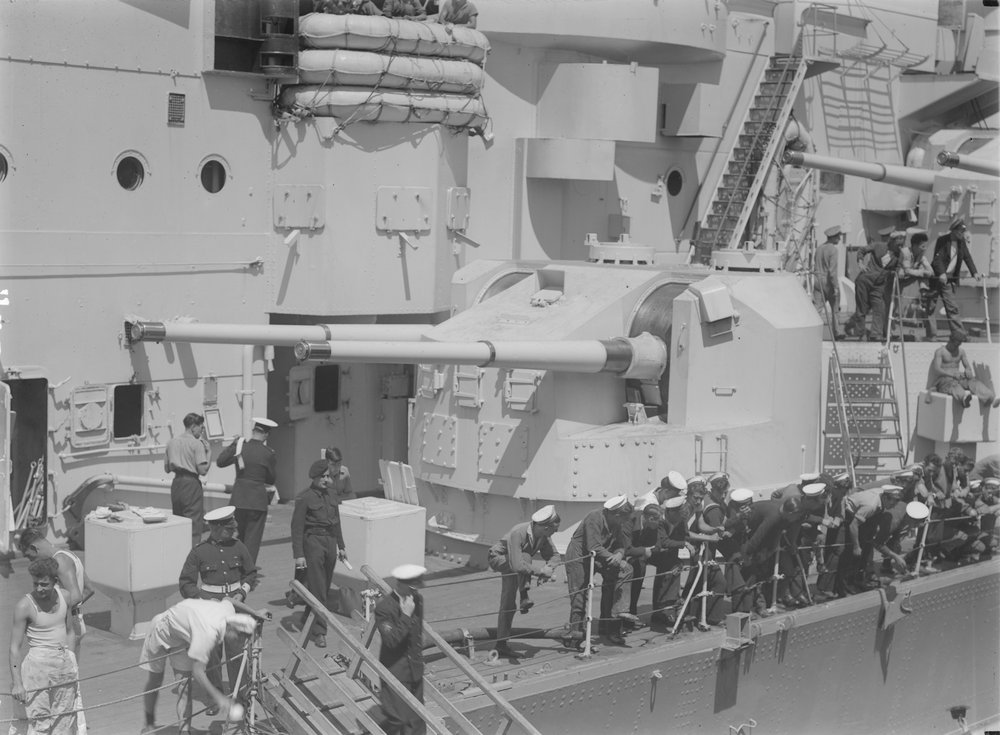
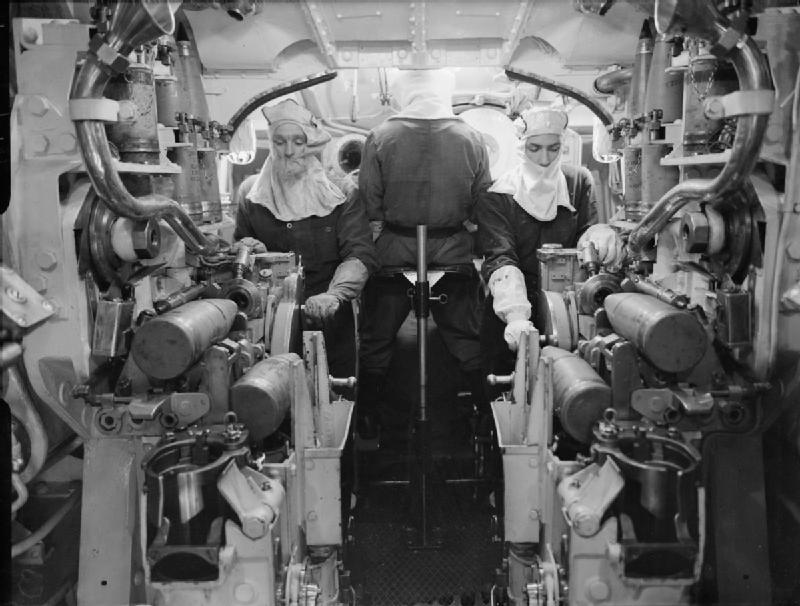
LA shell hoists are in the close foreground and these delivered projectiles vertically to the gunhouse. HA shells were delivered horizontally to the fuze setters as can be seen in this photograph. After the fuzes were set, the HA projectiles were removed from the rear and then placed into the loading trays, which are just out of sight in this photograph. Cartridge hoists are towards the back of the mounting and are also out of sight in this photograph.
A poor copy of this picture is used in "Battleship: The Sinking of the Prince of Wales and the Repulse" to illustrate the cramped conditions of the Mark I gunhouse. Besides
the three crewmen pictured here, there were also two gunlayers, a turret trainer, two breech workers, two projectile loaders and two cartridge loaders
for a total of twelve crewmen in the gunhouse.
IWM photograph A 15889.


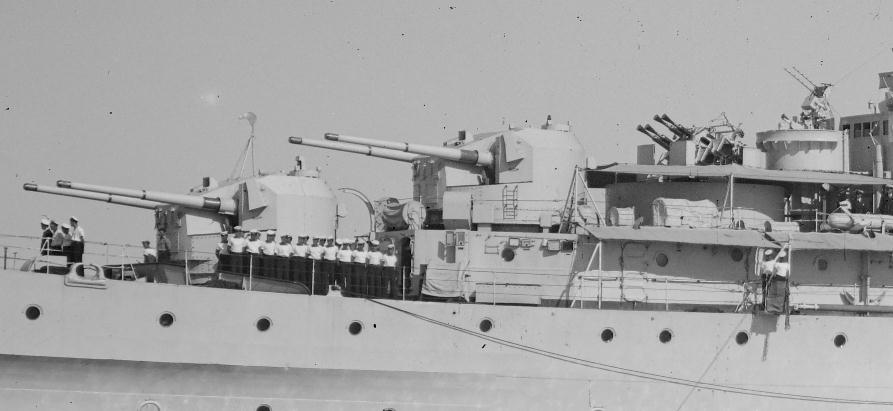
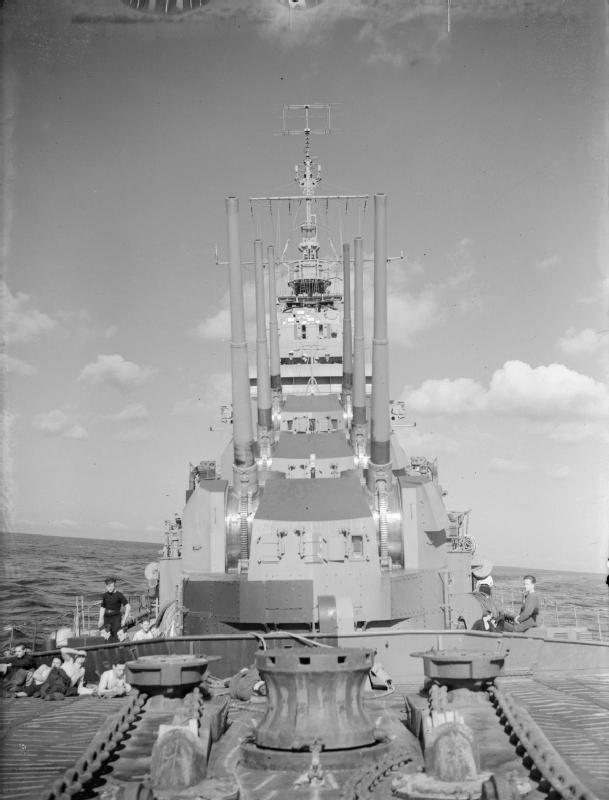
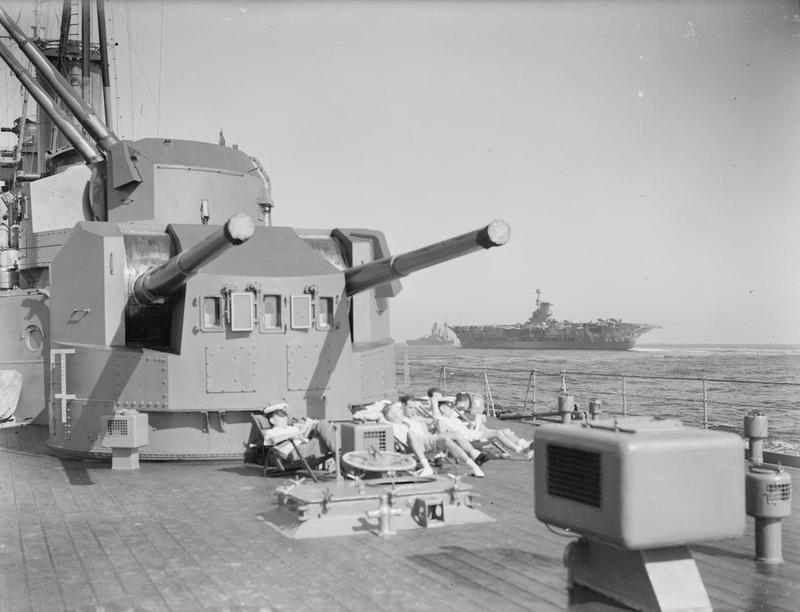
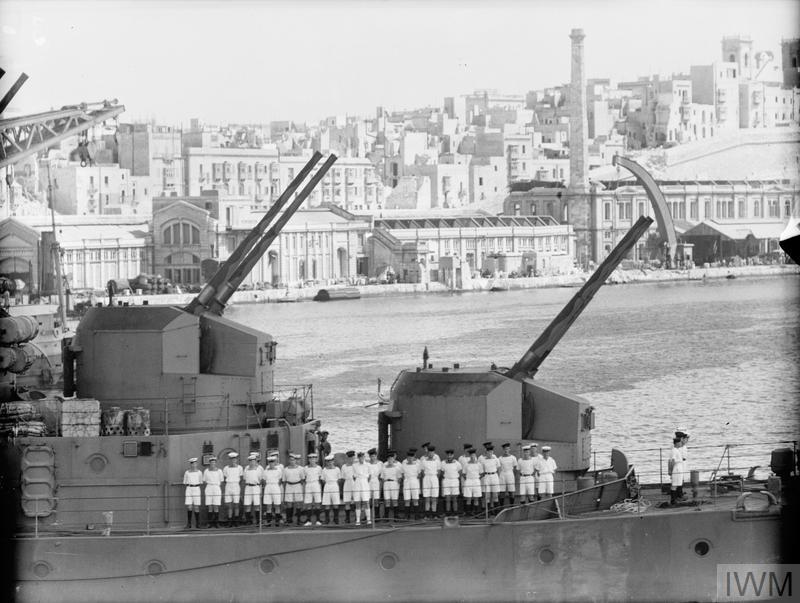
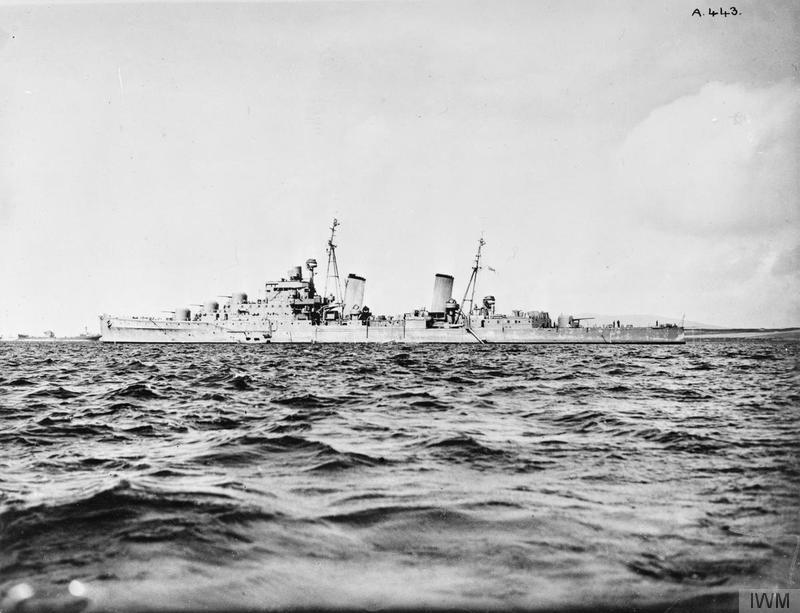
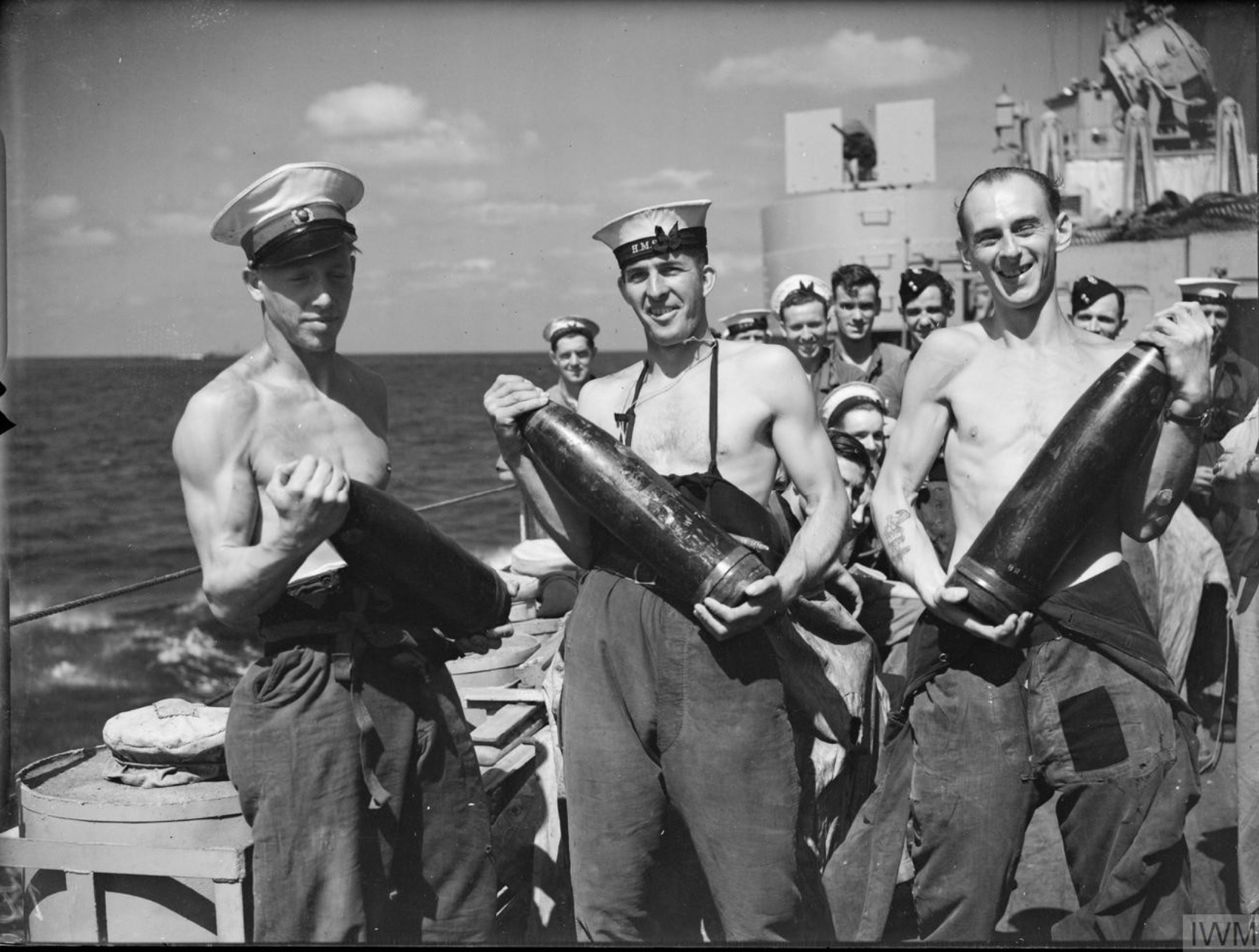
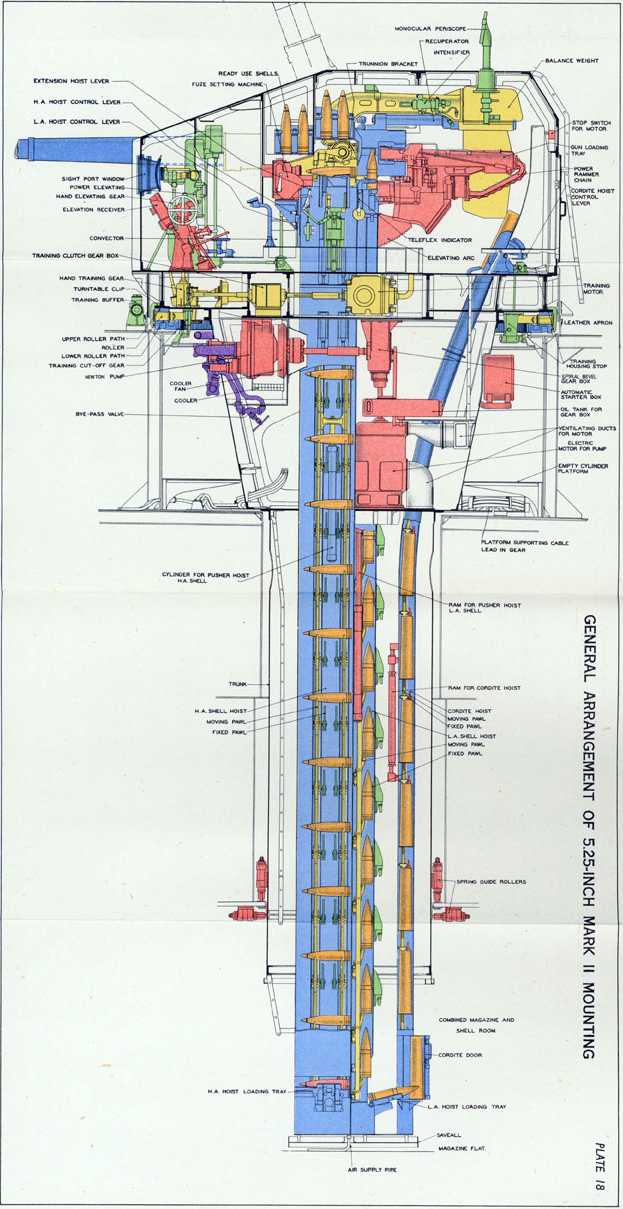
Images at The Vickers Photographic Archive
See 5.25
Squared-off single mountings in this series are Army coastal defense units
"Nelson to Vanguard: Warship Design and Development 1923-1945" and "The Design and Construction of British Warships 1939-1945: Major Surface Warships" both by D.K. Brown
"Naval Weapons of World War Two" and "British Naval Guns 1880-1945 No 14" article in "Warship Volume VIII" both by John Campbell
"Beware Raiders: German Surface Raiders in the Second World War" by Bernard Edwards
"Battleships: Allied Battleships in World War II" by W.H. Garzke, Jr. and R.O. Dulin, Jr.
"Warships of World War II" by H.T. Lenton and J.J. Colledge
"British Cruiser Warfare: The Lessons of the Early War, 1939-1941" by Alan Raven
"British Battleships of World War Two" and "British Cruisers of World War Two" both by Alan Raven and John Roberts
"King George V Class Battleships" by V.E. Tarrant
"Cruisers of World War Two" by M.J. Whitley
14 September 2008 - Benchmark
28 February 2012 - Added SAP projectile length and note on "K" shells
15 December 2013 - Added photographs of HMS Argonaut and interior of mounting
18 May 2014 - Added note regarding Bonaventure and Hipper
29 June 2014 - Added additional mounting information and gun weights
30 June 2014 - Added crew details in the caption for the interior photograph
12 September 2014 - Added note about ROF from"British Battleships of World War Two" and added photograph of HMS Hermoine
17 October 2014 - Added photograph of HMS Bonaventure
02 December 2015 - Changed Vickers Photographic Archive links to point at Wayback Archive and added note regarding ammunition stowage on Dido class
23 June 2016 - Converted to HTML 5 format
24 March 2017 - Added armor protection of Mark I*
14 September 2020 - Reorganized notes
13 February 2021 - Added photograph of Hermoine at Malta
29 November 2021 - Minor changes in ammunition section, corrected Muzzle Velocity, added notes about Army guns, Anti-radar projectiles and late-war removal of 'Q' turret
24 December 2021 - Added photograph of HMS Euryalus and comments by Adm Cunningham and Alan Raven regarding mounting problems
29 January 2022 - Corrected typographical errors
29 November 2023 - Updated armor table
26 February 2025 - Corrected typographical error
